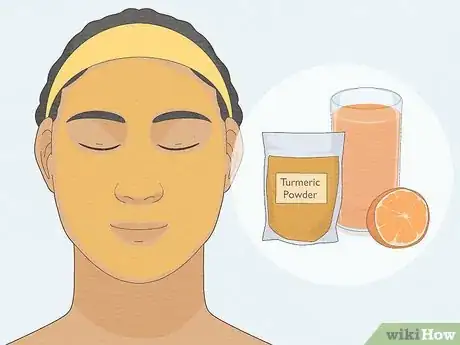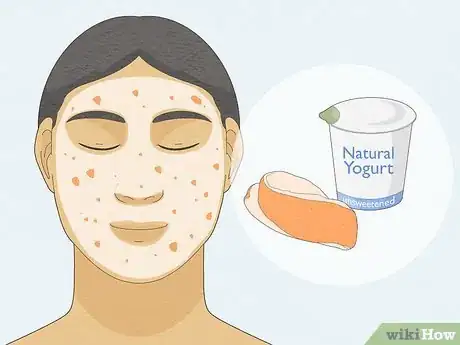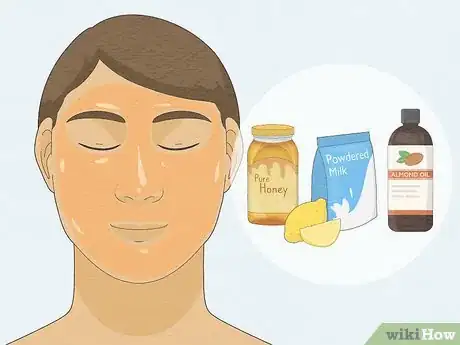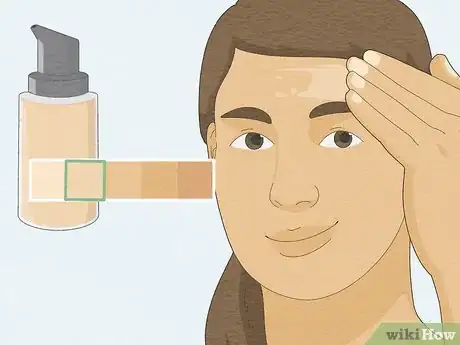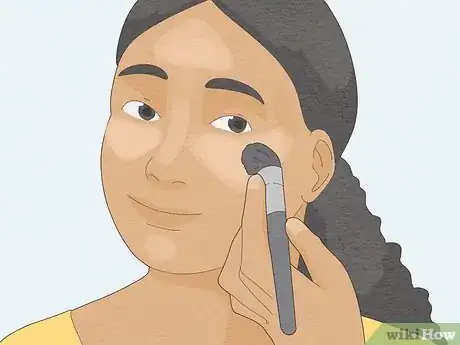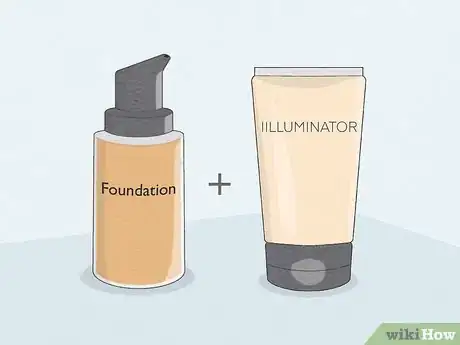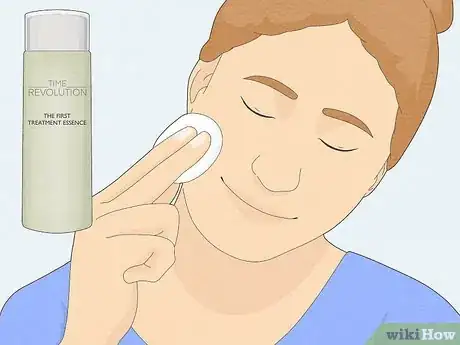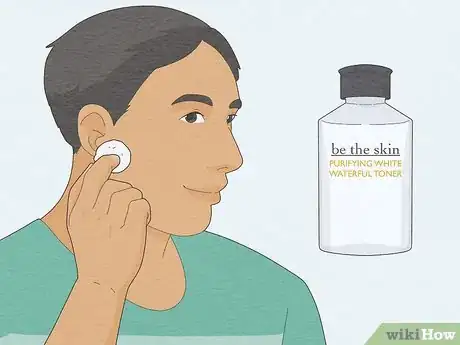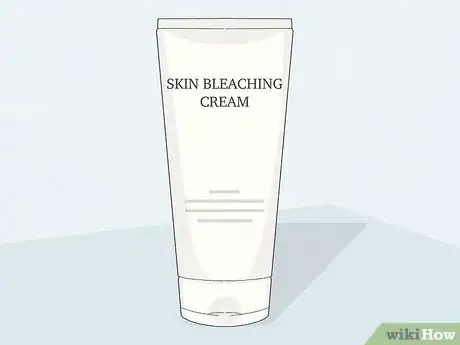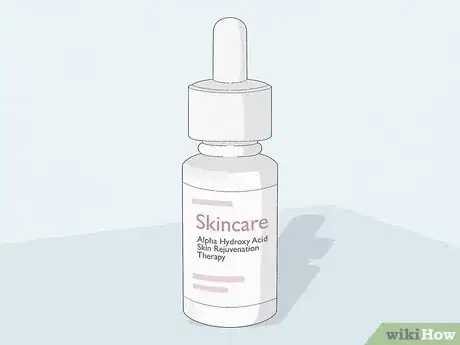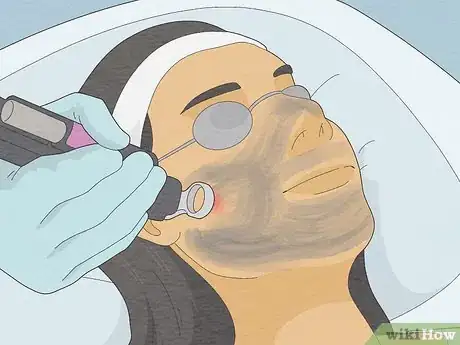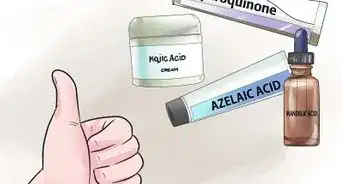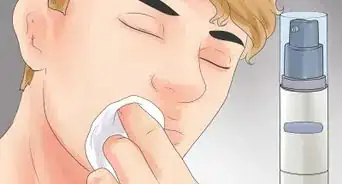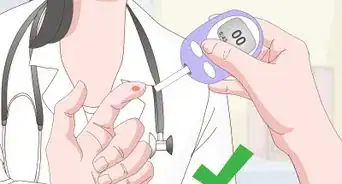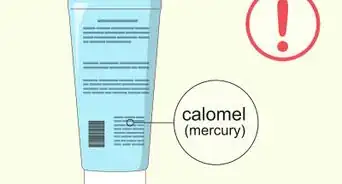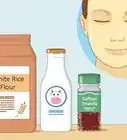This article was co-authored by Aanand Geria, MD. Dr. Aanand Geria is a board certified dermatologist, a clinical instructor at Mt. Sinai, and the owner of Geria Dermatology based in Rutherford, New Jersey. Dr. Geria's work has been featured in Allure, The Zoe Report, NewBeauty, and Fashionista, and he has peer-reviewed work for the Journal of Drugs in Dermatology, Cutis, and Seminars in Cutaneous Medicine and Surgery. He holds a BS from the Penn State University and an MD from Rutgers New Jersey Medical School. Dr. Geria then finished an internship at Lehigh Valley Health Network and a dermatology residency at the Howard University College of Medicine.
This article has been viewed 3,434,165 times.
You can achieve a healthy and youthful-looking complexion with any skin-tone. Whether you want to correct discoloration due to sun-exposure or aging, or you simply want fairer skin, medical science has some very good treatments. Even nature has its own solutions, too.
Steps
Using Natural Methods
-
1Mix orange juice with turmeric powder. The vitamin C in oranges is essential for healthy skin. It is also a great bleaching agent due to citric acid. Mix two tablespoons of orange juice and half a teaspoon of turmeric powder together. Apply the balm to the darkened areas, or all over your face, if you like. Leave it on overnight and rinse it off with water the next morning.
- Use this every day for the best results. Make sure that you completely cover the areas you want to lighten.
- Keep in mind that turmeric has a staining effect, so your skin might appear orange or tan after using this mixture, which is probably the opposite of the effect you're going for. Don't worry, once that effect fades, your skin will be subtly fairer because of the fruit acids and turmeric.
-
2Try mixing dried orange peel with yogurt. This makes a mask that you can use to lighten the skin of your face over-all. You'll first need to dry out an orange peel. Then, grind the peel into a fine powder and mix it with plain yogurt. Smooth the results over your face and leave it on for 20 to 30 minutes. Wash it off with water afterward. Repeat this two or three times per week.
- The lactic acid in yogurt and the citric acid in the orange peel are natural bleaches.
Advertisement -
3In a small bowl, mix one teaspoon of honey, one teaspoon of lemon juice, one tablespoon of powdered milk, and half a teaspoon of almond oil together. Apply the mixture to your skin and leave it on for about 10 of 15 minutes, then rinse it off in cold water. Use this mask every other day.
-
4Make a gram flour face mask. Gram flour, also known as chickpea flour or besan, is made from ground chickpeas (garbanzo beans.) It is well-known in India as an exfoliant and skin lightener. Combine two tablespoons of gram flour, a quarter tablespoon of turmeric powder, and two tablespoons of milk. Mix the ingredients together to form a smooth and fine-textured paste. Smooth the mask onto your face and neck. Leave it on your skin for about 20 or 30 minutes, then rinse it off with lukewarm water.
- You can use this mask on your body, too.
- Apply daily for the best results.
Lightening Your Skin Temporarily
-
1Resurrect a trend from 18th and 19th century France. Very pale skin was in vogue in France during the 1700s and 1800s, so aristocratic women would lighten their skin using cosmetics. We can learn from their mistakes; they typically applied paint made from lead! Instead, try these safe alternatives:
- Rather than matching your makeup to your face, select a shade of foundation one shade lighter than your actual skin color. Remember to also use concealer and setting powder one shade lighter than your skin. Blend the makeup into the skin at your jawbone and neck so that it fades gradually rather than leaving an obvious line that divides the pale skin on your face from the darker skin on your neck (or better yet, wear a turtleneck or scarf).
- You can try out a version of this tactic without spending a ton of money on new cosmetics by simply purchasing a finishing powder in a lighter shade. Apply it over your normal foundation and concealer, and if you like the effect, consider buying lighter foundation and concealer as well.
-
2Take advantage of the contouring trend. Most major cosmetics brands are jumping on the trend, which is also known as highlighting or strobing depending on the technique. You can adapt this trend to create the illusion of fairer skin temporarily. Contouring using makeup involves carefully placing lines of darker color on areas that are meant to recede, like under your cheekbones and along the sides of your nose, while placing lighter streaks of color along areas that are meant to stick out a bit and catch the light, like the cheekbones, bridge of the nose, or forehead. Then, the colors are carefully blended so that you can't tell that you've put color in either place, but it gives a very nice visual effect of well-defined facial features.
- Learn about contouring techniques from this helpful wikiHow article, but when you go shopping for products, purchase products in shades slightly lighter than you would normally buy.
- Apply the products using the contouring technique, but at each step, go one to two shades lighter than you would normally go. For instance, when you begin, apply foundation to your entire face in one or two shades lighter than your skin tone. Then, when you contour the darker areas, use a color that matches the natural color of your face (rather than a darker shade). The highlighted, lighter areas should be a shade or two even lighter than the color you began with to really stand out.
- It's important to stay in the same color family as the rest of your skin. If you are cool-toned, choose products that are meant for cool-toned skin; and if you are warm-toned, choose products that are meant for warm-toned skin. Otherwise your contouring will seem like you've painted your face.
-
3Use highlighting cream.[1] For a more subtle effect, simply mix a highlighting cream into your regular foundation. It will only subtly lighten the actual color of your skin, but because of its very fine sparkle and luminosity, it will make your complexion appear fairer in the light.
- Try Josie Maran Argan Enlightenment Illuminizer, NARS Illuminator, or a similar product from your favorite drugstore brand. The key is to choose a liquid highlighter that can be easily blended into liquid foundation, and in a shade that is slightly lighter than your skin tone but in the same color family.
- The end result should be skin that seems to glow, like a freshly moisturized face; if it seems glittery or shiny then you've added too much illuminator to your foundation.
Trying OTC Lightening Products
-
1Try lotions or creams containing niacinamide (Vitamin B3). This active ingredient is popular in Asian countries, where fair and luminous skin is generally in fashion, as well as in the United States and other places as an aid in fading dark spots, removing tans and evening skin tone.[2]
- You can purchase a serum of 5% niacinamide online or in health food and general nutrition stores. It is thought to improve the condition and elasticity of the skin as well as improving skin tone.
- You can also look for products with niacinamide as an active ingredient. Some popular brands include Kate Somerville's Mega-C Dual Radiance Serum, Philosophy No Reason To Hide Multi-Imperfection Transforming Serum, or Missha Time Revolution The First Treatment Essence.
-
2
-
3Consider using other fruit acids. Acids in fruits work by exfoliating the outer layer of the skin, essentially mimicking a very mild chemical peel which fades dark spots on the surface of the skin.[6]
- Try Goodal Luminant Plus Whitening Essence, Peter Thomas Roth Glycolic Acid Hydrating Gel, REN Glycol Lactic Radiance Renewal Mask, or Ole Henriksen Lemon Strip Flash Peel.
Using Prescription Creams, Chemical Peels, and Lasers
-
1Use a skin bleaching cream. Most skin bleaching creams contain the drug hydroquinone[7] as the active ingredient. You can purchase varieties which contain two percent or less of this drug at your local drugstore, while you need a prescription to get more powerful creams.[8] These have between four to six percent hydroquinone. Use as directed on the package or by your doctor. This generally means applying it no more than twice daily. As with any other drug, hydroquinone has its risks. They include:
- Premature aging
- Increased risk of skin cancer. The reason for this is that skin treated with hydroquinone is more sensitive to sunlight.
- Skin discoloration
- Allergic reaction
-
2Consider a chemical peel.[9] A chemical peel is a procedure in which chemicals are applied to the skin, usually the face, which cause the skin to exfoliate and peel away. Depending on how deeply into the skin they penetrate, chemical peels come in three varieties: superficial, medium, and deep.
- Superficial peels use alpha-hydroxy acid and only penetrate the outer layer of the skin. Choose this method if the skin discoloration you are trying to address is minor. Recovery time is a day or so.
- Medium peels use glycolic or trichloracetic acid and penetrate the outer and middle layers of the skin. They are suitable for moderate skin discoloration. Because medium peels penetrate deeper into the skin, it can take 14 days to heal after a treatment.
- Deep peels are the most invasive and as such, are suitable for the most extreme cases of skin discoloration. Deep peels use trichloracetic acid or phenol, which deeply penetrate into middle layer of the skin. Because of this, they can only be performed once in a person's lifetime. Healing time is the most extensive: 14 to 21 days.
- Regardless of the type of peel, there are risks. They include scarring and the reactivation of cold sores
-
3Try laser skin resurfacing with the q-switch nd:YAG laser. Laser skin resurfacing works by targeting and destroying the unwanted skin cells with high energy light. The body then generates new skin cells and increases its production of collagen, one of the building blocks for great skin. It does this without damaging the top layer of the skin, which means that there is no downtime. The recommended treatment schedule is six cycles over a two week period. You'll see noticeable results after every treatment, which continue to improve over time.
- q-Switch refers to this laser's ability to operate at two wavelengths: 1064 nm, or infrared, and 532 nm.[10] The Nd:YAG refers to the laser's crystal structure, which is neodymium-doped yttrium aluminum garnet.
- Minor side-effects such as some skin redness can occur, but this usually resolves within 30 minutes of the procedure.
Expert Q&A
Did you know you can get expert answers for this article?
Unlock expert answers by supporting wikiHow
-
QuestionWhat can I do to make my skin lighter?
 Aanand Geria, MDDr. Aanand Geria is a board certified dermatologist, a clinical instructor at Mt. Sinai, and the owner of Geria Dermatology based in Rutherford, New Jersey. Dr. Geria's work has been featured in Allure, The Zoe Report, NewBeauty, and Fashionista, and he has peer-reviewed work for the Journal of Drugs in Dermatology, Cutis, and Seminars in Cutaneous Medicine and Surgery. He holds a BS from the Penn State University and an MD from Rutgers New Jersey Medical School. Dr. Geria then finished an internship at Lehigh Valley Health Network and a dermatology residency at the Howard University College of Medicine.
Aanand Geria, MDDr. Aanand Geria is a board certified dermatologist, a clinical instructor at Mt. Sinai, and the owner of Geria Dermatology based in Rutherford, New Jersey. Dr. Geria's work has been featured in Allure, The Zoe Report, NewBeauty, and Fashionista, and he has peer-reviewed work for the Journal of Drugs in Dermatology, Cutis, and Seminars in Cutaneous Medicine and Surgery. He holds a BS from the Penn State University and an MD from Rutgers New Jersey Medical School. Dr. Geria then finished an internship at Lehigh Valley Health Network and a dermatology residency at the Howard University College of Medicine.
Board Certified Dermatologist
References
- ↑ Jason Phillip. Handyman. Expert Interview. 2 July 2020.
- ↑ http://www.refinery29.com/skin-lightening
- ↑ Jason Phillip. Handyman. Expert Interview. 2 July 2020.
- ↑ http://peachandlily.com/blogs/news/50376645-fight-hyperpigmentation-with-brightening-products
- ↑ http://peachandlily.com/blogs/news/50376645-fight-hyperpigmentation-with-brightening-products
- ↑ http://peachandlily.com/blogs/news/50376645-fight-hyperpigmentation-with-brightening-products
- ↑ http://www.webmd.com/drugs/2/drug-87530/hydroquinone-skin-bleaching-top/details
- ↑ Jason Phillip. Handyman. Expert Interview. 2 July 2020.
- ↑ Jason Phillip. Handyman. Expert Interview. 2 July 2020.
About This Article
To get fair skin in 2 weeks, apply a mixture of orange juice and turmeric to your face each night before you go to bed. In the morning, use cold water to wash out the mixture, which will bleach your skin with citric acid. Alternatively, mix 1 teaspoon of honey, 1 teaspoon of lemon juice, 1 tablespoon of powdered milk, and 1/2 teaspoon of almond oil to create a mask. Once the mixture is ready, apply it to your face for 15 minutes before rinsing it off. If you just want to lighten your skin temporarily, use a foundation and concealer on your face that are a shade lighter than your skin color. Next, blend in the makeup at your jawline so the line between your natural skin color and the lighter areas are less obvious. For tips on how to use over-the-counter creams to lighten your skin, keep reading!
